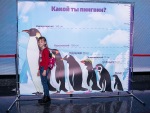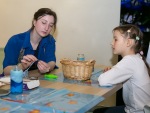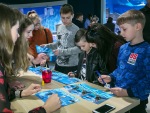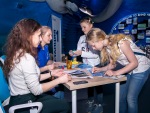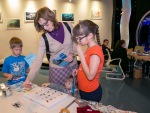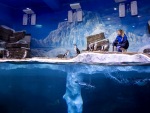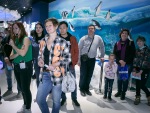Sweaters over tuxedoes: what we know about penguins.
World Penguin Day, an important and entertaining environmental holiday, has been celebrated in a positive atmosphere at the Primorsky Aquarium.
Though, it is the first time that the Aquarium has observed World Penguin Day, this holiday is not a new one. On the 25th April each year, conservation organizations spend the day raising awareness for the world’s most unusual bird.
“I am very glad that we have attended the event since it is a good chance for us to learn more about these funny birds,” said Maria, a visitor to the Aquarium. “My family and I happened to be here on the environmental holiday, and we did not even expect to participate in the celebration during an ordinary visit to the Aquarium.”
Passing along an educative route through the exhibits, the Aquarium’s visitors got to know a lot of interesting facts. Some participants were surprised to find out that not all penguin species lived in Antarctica. Only four of them inhabit the world’s coldest continent: emperors and Adélies breed on the mainland of Antarctica while chinstraps and gentoos make nests on the Antarctic Peninsula. But all penguin species are native to the Southern Hemisphere and can be found in Australia, New Zealand, South Africa, Chile, Peru and on the Galapagos and Falkland Islands.
Each route point was dedicated to a separate penguin species. At the first station called “New Zealand Penguin” the visitors were told about an extinct penguin species. According to scientists' findings, the birds stood up to 170 cm tall and were the largest of all the penguin species. In addition, at that station visitors could learn how penguins had originated and how they had received their name. The word “penguin” has 3 meanings: “fat”, “pin wing” and “white head”. This name is considered to have been originally applied to another bird species – the great auk – which was a large bird with black and white plumage and wings transformed into flippers; it waddled along beaches and swam in the arctic waters. The species was last recorded in the middle of the 19th century, and now it is extinct.
At the “Emperor Penguin” station, Antarctic penguin species and their adaptations to life in the cold were discussed.
The third station was located at the Polar World exhibit where a flock of Humboldt penguins reside; it provided information on this species. An unusual press-conference took place there. While feeding the birds, our ornithologist answered the visitors’ questions. They wondered why penguins were excellent swimmers and slow walkers, if they made friends, how much food they consumed, what their pool temperature was, if the Aquarium penguins would grow larger, and so on.
At the “African Penguin” station our specialists spoke about the causes of decline in penguin population, they also explained the importance of World Penguin Day, the necessity of protecting penguins and described the means of preserving them. For instance, the African penguin is on the brink of extinction because native tribes have been eating their eggs for centuries, the Antarctic species are threatened by melting ice, and little penguins suffer from oil spillage.
The last station was dedicated to this very species, also called the fairy penguin. There the Aquarium’s visitors learnt why the little birds needed sweaters. They are not snappy dressers at all, sweaters are meant to save penguins caught in oil spills. Firstly, they prevent the birds from preening toxic oil off their plumage and then ingesting it while the penguins wait for their turn to be washed. Secondly, sweaters protect the penguins from hypothermia. The crude oil from the spills destroys the natural oils on their feathers that usually keep the birds warm.
“I heard of this problem during a Science lesson at my school,” said Konstantin, a participant in the event. “They are very small, and I feel so sorry for them. It is great that people help little penguins, and I would love to knit a sweater for a penguin too.”
After the celebration, some visitors attended a workshop called “The Colours of Antarctica” where they either made a key fob with penguin feathers or painted a penguin on a pebble to keep them as souvenirs. The participants have gained not only vivid impressions and interesting knowledge but also reminders that if we want to continue admiring these nice birds, we should take care of them.
